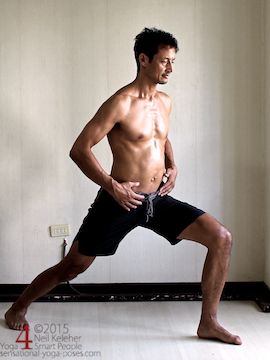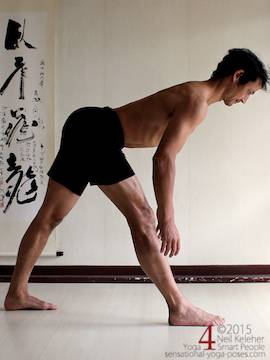Standing Spinal Back Bends
To help students get more intimate with their spine in general, I'll often start yoga classes with a standing spinal back bending exercise.
Lifting the Tailbone
A very simple start to spinal backbending (that leads to thoracic backbending or "thoracic extension") is to lift the tailbone so that the pelvis tilts forwards.
I tell people to focus on the tailbone because generally this is easier to grasp than the idea of the pelvis. Plus it's a handy landmark for other actions and since the spine is the focus here, and the tailbone is at the bottom of the spine then it simply gets people tuned in to that part of their body.
So the instruction is to lift the tailbone then relax.
Generally when relaxing the pelvis returns to the neutral or starting position.
We repeat this movement so that people can get used to the movement and also so that they understand what I mean whenever I say "Lift the Tailbone."
Practicing Lumbar Spinal Extension
The next step is to notice the increase in back bend of the lumbar spine as the tailbone lifts.
When referencing backward bending and forward bending the idea is that
- a backward bend bends around something behind the body (technically extension)
- while a forward bending action bends around something in front of the body.
Lifting the tailbone while keeping the ribcage upright causes the lumbar spine to bend backwards. When returning the tailbone to the start position the backward bend in the lumbar spine is reduced.
Tuning in to the Lumbar Spinal Extensors
The next step is to tune into the sensation that accompanies the backbend of the lumbar spine.
Generally the sensation is a contractive feeling on either side of the lumbar spine. The more you bend backwards the greater the contractive feeling. Conversely the more you amplify the contractive feeling the easier it is to increase the back bend.
The contractive feeling comes from the spinal erectors activating. The feeling should dissipate during the relaxation phase of the exercise.
Tuning in to this sensation students now have a way of recognizing when they are actively (using muscle power) back bending the lumbar spine.
I think the technical term for this is "Somatic Awareness". I tend to write "feel the body" or "sense the body" (hence "Sensational" yoga poses.)
Extending the Thoracic Spine
The next phase is to carry this contraction up to the back of the thoracic spine and ribcage so that the thoracic spinal erectors also activate. This can be difficult but if they can at least feel the lumbar spinal erectors activating they then have a better change of also learning to activate the thoracic spinal erectors.
This is where we get into strengthening a tight or weak upper back.
One thing to be alert for is students using their shoulders to help the back bend.
Usually I tell students to keep their shoulders relaxed.
If they can't do that then I have them hold the spinal back bend (lumbar and thoracic both) and then have them move their shoulders forwards (protraction) and then backwards (retraction) while continuing to hold the back bend.
Note that this backbend tends to focus on the spinal erectors because they are easy to feel when active.
Educating the Thorax
A further stage to strengthening the upper back and increasing thoracic mobility is to also educate the intercostal muscles, the muscles that lay between adjacent ribs.
To expand the focus to include the ribs, I'll have students focus on lifting and expanding the ribcage after bending their thoracic spine backwards.
For further training the exercise can be to focus on and "isolate" the thoracic spine.
Isolating the Thoracic Spine and Ribcage
The lumbar spine and pelvis can move or adjust but the idea is to isolate the thorax or simply focus on it as much as possible.
The exercise can start with sinking the chest down so that the thoracic spine bends forwards. This can be a relaxed forward bend letting the weight of the ribcage sink down or it can be active, using the abs to pull the ribs down. Then slowly lift and expand the ribcage (to focus on the intercostals.)
A compliment is to pull the head up and back with the chin down.
Then relax and let the ribs sink down. (The head can be allowed to move forwards and down.)
I like to instruct students to sink the ribs because this then gives a fuller range of movement. This leads to fuller breaths. It also leads to better awareness since it is easier to feel bigger movements.
Next after a few repetitions I have them bring some awareness to the thoracic spine. After lifting the ribs focus on bending the thoracic spine backwards. Then when sinking the ribcage bend the thoracic spine forwards.
Note that all actions I have my students do slowly and smoothly. If I'm facing a mirror with the students behind me I can usually spot sharp or unsmooth actions and I'll single out that student and ask them to slow it down. Some people I have to stand next to and do the movement with them so that they have an example to match speeds with.
Generally once they get it they keep doing it. I like to think that this is because it feels good.
Using the Same Exercises in Various Yoga Poses
Now this is a very simple movement and the beauty of it is that it can be used in a variety of poses both standing and sitting.
An obvious example is Warrior 1.
Warrior 1
Start with the legs in the Warrior 1 position but with the arms down.
- Sink the chest and bend the upper back forwards.
- Then lift the chest and bend the upper back rearwards.
- Repeat a few times and then add the arms. Lift the arms as the chest lifts, lower them as the chest lowers.
- Repeat a few times then keep the arms lifted while lifting and lowering the chest.
- Keeping arms lifted, try relaxing the shoulders as you lower the chest then reach the shoulders up as you lift the chest.
Note that with the arms lifted it will be harder to sink the chest when relaxing.
Generally I may have students separate their hands when relaxing and then bring them together when lifting the the chest and bending the thoracic spine backwards.
Triangle Forward Bend (Parsvottanasana)
One of my favorite upper back exercises is triangle forward bend (purvottanasana) but without the hands in prayer. Instead I have my students put their hands on the floor or on blocks if their arms are too short.
- The exercise is then to lift the hands and then bend the thoracic spine backwards.
- Reach the chest forwards.
- Then relax, placing the hands back on the floor or on yoga blocks if they are being used.
Some students don't get the connection between this exercise and the previous one.
I may stand them back up again and have them repeat the standing thoracic back bend but this time noticing how the front of the ribcage moves away from the front of their pelvis when backbending the upper back.
Or I have them notice their spinal erectors contracting when the upper back bends backwards. in their back.
And I may have to point out the difference between tilting the pelvis backwards and forwards without allowing the spine to bend versus tilting the pelvis backwards and forwards while allowing the spine to bend as shown in the two sets of pictures below.
Tilting the pelvis forwards and bending the spine backwards.
Tilting the pelvis backwards without allowing the bend in the spine to change
To add weight to the triangle forward bending exercise I'll have them reach their arms forwards after opening the chest.
Standing Forward Bend
A similar action can be done in a regular standing forward bend.
For this I prefer to simply have them have hands on the floor or on blocks as opposed to grabbing toes or sliding their hands under their feet.
Here they can lift their hands and then bend their thoracic spine backwards.
Another option that I like is to have them keep their hands on the floor and then shift their weight forwards so that they feel their arms activate as their weight shifts forwards.
I'll have their either open their chest prior to rocking forwards, as they rock forwards or after they rock forwards. I like to use different instruction sequences so that they can feel for themselves which sequencing works best. (And it may change from day to day.)
Hurdler's Stretch
A similiar sequence can be used in a seated forward bend.
My favorite seated forward bend right now is hurdlers stretch but you can use it in any other forward bend if you don't like this one. I have them start with hands on the floor.
- Open the chest, then lift the hands.
- For beginners I'll have them brace the leg prior to lifting the hands.
- Then reach the hands forwards keeping them off of the floor.
- Then put the hands back on the floor, relax, then repeat.
Spinal Front Bends
Note that to counterpose all of this spinal backbending I like to use spinal front bending.
In a standing position this can mean dropping the tailbone so that the pelvis tilts back.
The feeling to look for is a feeling of openness in the lower back.
Balancing the Shoulders
Since the shoulders tie in to the upper back it can be important to balance shoulder actions. So if for example I have had students do warrior 1 or any other pose with the arms up over their head then a balancing action is some yoga pose or exercise where the arms are behind the back.
Doing a standing forward bend with feet shoulder width or wider I could have students clasping their hands behind their back.
Another option is to stand upright and reach the hands backwards. To turn this into an upper back exercise, hold the arm position and bend the spine backwards and forwards.
Table Top Yoga Pose
Table top yoga pose is another good "hands behind the back" exercise.
In table top I'll often teach this same awareness.
With shoulders relaxed so that the ribcage sinks down relative to their shoulders I'll have them bend their thoracic spine backwards and forwards. Then I'll have them repeat these actions while using the shoulders to push the ribcage up away from the floor.
Twisting the Upper and Lower Back
Note that a weak upper back may be due to a lack of ribcage awareness. Some of my favorite exercises for the ribcage in general are twists.
Standing Twist
A simple standing twist that can be done in between other standing poses is to stand with feet hip or shoulder width.
- Brace the legs to keep the pelvis facing front and use the abs and intercostals to turn the ribcage to the right and then left.
- In this exercise you can stretch and activate the spinal erectors by alternately bending the thoracic spine forwards and backwards.
Twisting Triangle
A variation of the triangle forward fold is twisting triangle.
This can be done straight after Triangle Forward Fold. Turn towards the front-leg-side. Here again you can focus on keeping the pelvis stable (using the legs) and while keeping the twist bend the thoracic spine backwards (you can optionally lift the lower hand) and then bend it forwards (put the lower hand back on the floor.)
Earlier I said that when doing spinal back bends I invite students not to use their shoulders or at least to learn to feel when they are moving their shoulders relative to their ribcage and when they are bending their ribcage and thoracic spine backwards and forwards.
Published: 2015 01 23


























